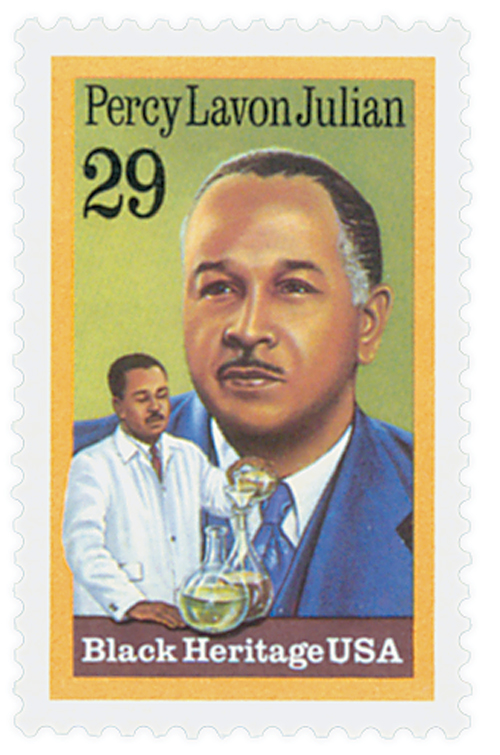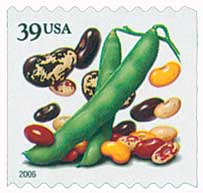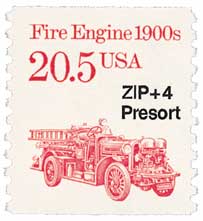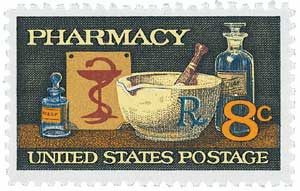
# 4004 - 2006 39c Crops of America: Beans, coil
2006 39¢ Beans
Crops of America
City: New York, NY
Chemist Percy Lavon Julian was born on April 11, 1899, in Montgomery, Alabama. Julian was one of the first African Americans to receive a doctorate in chemistry, and the first to be inducted into the National Academy of Sciences. He owned more than 100 chemical patents and was a pioneer in chemical synthesis of drugs used in medicine. The son of a railway mail clerk, Julian was the oldest of six children. He went to DePauw University in Greencastle, Indiana, but wasn’t allowed to live in the dormitory. He eventually found work doing odd jobs at a fraternity house where he could live in the attic. Julian graduated as valedictorian in 1920. Julian hoped to get a doctorate in chemistry next, but this was difficult for African Americans at that time, so he worked as a chemistry teacher at Fisk University. Eventually, he received a Rockefeller Foundation fellowship to complete his graduate work at the University of Vienna and earned his Ph.D. in 1931. He was the third African American to earn a Ph.D. in chemistry. Julian went on to teach at Howard University for a year and then his alma mater DePauw. While back at DePauw teaching organic chemistry, he completed the total synthesis of physostigmine (an alkaloid found in the Calabar bean). He confirmed its structural formula and melting point and hoped to use it to synthesize human steroidal hormones. In 1936, Julian was passed over for a professorship at DePauw. He applied for jobs at a few different places but was denied because of his race. He then wrote to the Glidden Company to request a five-gallon sample of their soybean oil for his research. They ended up hiring him as their director of research. Julian immediately went to Chicago and oversaw the construction of the world’s first plant to produce industrial-grade, isolated soy protein from oil-free soybean meal. This protein was an affordable replacement for milk casein and could be used for coating paper, glue, and water-based paints. During World War II, Julian’s work with soy protein led to the development of Aer-O-Foam, the US Navy’s firefighting “bean soup.” The soy protein foam was used to put out oil and gasoline fires on ships, and was credited with saving the lives of thousands of sailors and pilots. While at Glidden, Julian also began synthesizing the hormones progesterone, estrogen, and testosterone from soybean oil. He developed and patented a new foam technique to do this. It was quicker and more efficient than existing methods used at the time, and provided much more of the of the chemicals. This work made the production of these hormones on a larger scale much more affordable, helping to save the lives of many people suffering from hormonal deficiencies. In 1949, Julian developed an improved process for creating cortisone, which was used to treat rheumatoid arthritis. Previously, it took a complicated 36-step process and used expensive chemical compounds. Julian left Glidden in 1953 to form his own company, Julian Laboratories. The company specialized in synthesizing steroids from Mexican yams, which helped to lower the costs of steroids and make several medicines more widely available. Julian sold his company in 1961 and founded Julian Associates and Julian Research Institute, which he oversaw until his death from liver cancer on April 19, 1975. Julian received several honors in his lifetime – he was the first African-American chemist inducted into the National Academy of scientists, received the NAACP’s Spingarn Medal, and was named the 1950 Chicagoan of the Year by the Chicago Sun-Times. There’s also a science award named for him, as well as schools, parks, and more.Birth of Percy Lavon Julian






2006 39¢ Beans
Crops of America
City: New York, NY
Chemist Percy Lavon Julian was born on April 11, 1899, in Montgomery, Alabama. Julian was one of the first African Americans to receive a doctorate in chemistry, and the first to be inducted into the National Academy of Sciences. He owned more than 100 chemical patents and was a pioneer in chemical synthesis of drugs used in medicine. The son of a railway mail clerk, Julian was the oldest of six children. He went to DePauw University in Greencastle, Indiana, but wasn’t allowed to live in the dormitory. He eventually found work doing odd jobs at a fraternity house where he could live in the attic. Julian graduated as valedictorian in 1920. Julian hoped to get a doctorate in chemistry next, but this was difficult for African Americans at that time, so he worked as a chemistry teacher at Fisk University. Eventually, he received a Rockefeller Foundation fellowship to complete his graduate work at the University of Vienna and earned his Ph.D. in 1931. He was the third African American to earn a Ph.D. in chemistry. Julian went on to teach at Howard University for a year and then his alma mater DePauw. While back at DePauw teaching organic chemistry, he completed the total synthesis of physostigmine (an alkaloid found in the Calabar bean). He confirmed its structural formula and melting point and hoped to use it to synthesize human steroidal hormones. In 1936, Julian was passed over for a professorship at DePauw. He applied for jobs at a few different places but was denied because of his race. He then wrote to the Glidden Company to request a five-gallon sample of their soybean oil for his research. They ended up hiring him as their director of research. Julian immediately went to Chicago and oversaw the construction of the world’s first plant to produce industrial-grade, isolated soy protein from oil-free soybean meal. This protein was an affordable replacement for milk casein and could be used for coating paper, glue, and water-based paints. During World War II, Julian’s work with soy protein led to the development of Aer-O-Foam, the US Navy’s firefighting “bean soup.” The soy protein foam was used to put out oil and gasoline fires on ships, and was credited with saving the lives of thousands of sailors and pilots. While at Glidden, Julian also began synthesizing the hormones progesterone, estrogen, and testosterone from soybean oil. He developed and patented a new foam technique to do this. It was quicker and more efficient than existing methods used at the time, and provided much more of the of the chemicals. This work made the production of these hormones on a larger scale much more affordable, helping to save the lives of many people suffering from hormonal deficiencies. In 1949, Julian developed an improved process for creating cortisone, which was used to treat rheumatoid arthritis. Previously, it took a complicated 36-step process and used expensive chemical compounds. Julian left Glidden in 1953 to form his own company, Julian Laboratories. The company specialized in synthesizing steroids from Mexican yams, which helped to lower the costs of steroids and make several medicines more widely available. Julian sold his company in 1961 and founded Julian Associates and Julian Research Institute, which he oversaw until his death from liver cancer on April 19, 1975. Julian received several honors in his lifetime – he was the first African-American chemist inducted into the National Academy of scientists, received the NAACP’s Spingarn Medal, and was named the 1950 Chicagoan of the Year by the Chicago Sun-Times. There’s also a science award named for him, as well as schools, parks, and more.Birth of Percy Lavon Julian
















